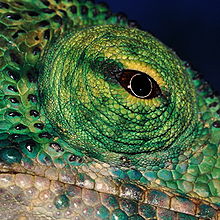Chameleon vision
[1] Unique features of chameleon vision include a negative lens, a positive cornea, and monocular focusing.
[2] With a negative (nearsighted or concave) lens and a positive (farsighted or convex) cornea, chameleons use a method of monocular focusing to judge distance called corneal accommodation.
[3] The combination of a negative lens and a positive cornea in the chameleon eye allow for accurate focusing by corneal accommodation.
[3] Contrary to the previous belief that chameleons used stereopsis (both eyes) for depth perception, research has shown monocular focusing to be more likely.
[6] Depending on the chameleon's step in the predation sequence, corneal accommodation can be coupled, meaning the eyes independently focus on the same object.
"[5] An important effect of the ability to judge distance with one eye is that the head does not have to be turned to allow stereoptic viewing of the object.
[1] In predator avoidance, chameleons use minimal head movement and a unique method to monitor potential threats.
Due to nodal point separation, a chameleon can judge distance to a potential threat with minimal head movement needed.
When confronted with a potential threat, chameleons rotate their slender bodies to the opposite side of their perch to avoid detection.
This is because the environmental circumstances such as the need for camouflaged quick prey capture that led to the development of the chameleon eye seem to have acted on the sandburrower fish as well.
[3] A nearly complete eyelid covering and lack of head movement due to nodal separation reduce conspicuousness to prey and predators.
